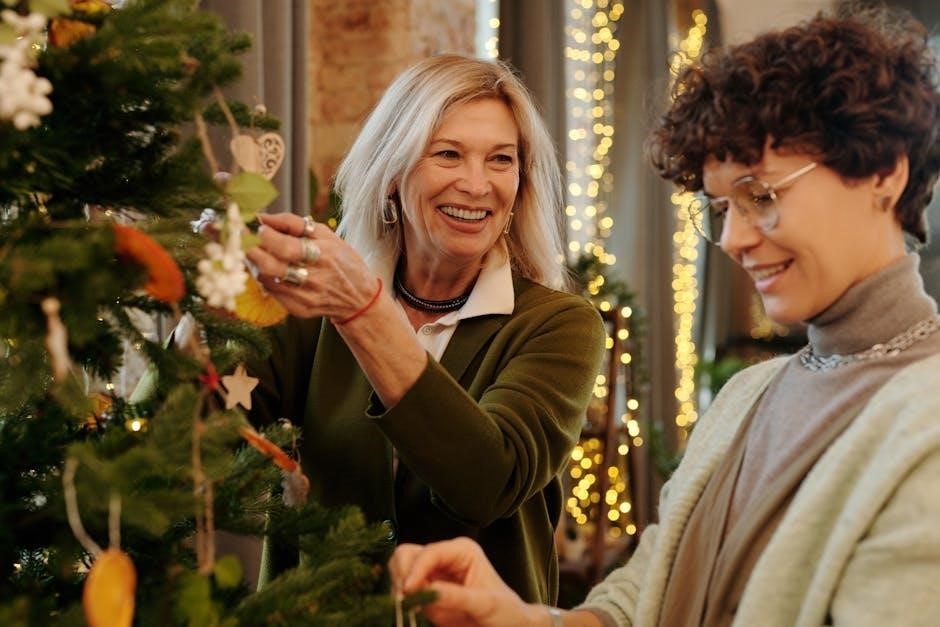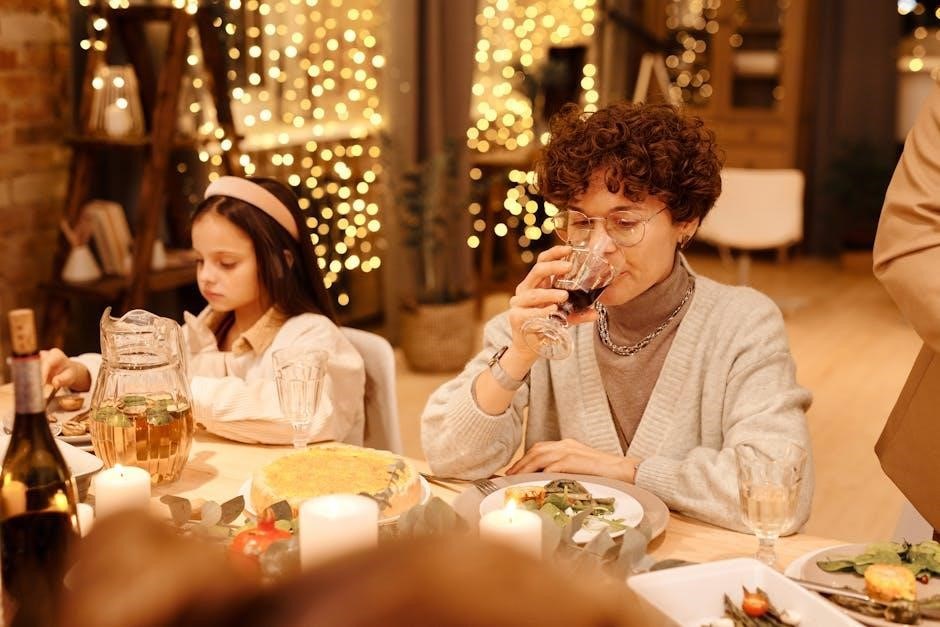Yule, a 12-day celebration from December 25 to January 6, blends ancient traditions with modern spirituality. It offers a meaningful way to connect with heritage through rituals, recipes, and reflection.
Discover how to embrace this festive period with guides like A Guide to Celebrating the 12 Days of Yule, blending history, folklore, and contemporary practices for a holistic celebration.
What is Yule?
Yule, an ancient winter festival, marks the longest night and the rebirth of the sun. Rooted in pre-Christian European traditions, it symbolizes renewal and the return of light. Celebrated from December 25 to January 6, Yule blends pagan rituals with modern practices, offering a time for reflection, feasting, and connection with nature. Central symbols include the Yule log, evergreen trees, and holly, representing life and resilience during winter. This period is cherished for fostering community, spiritual growth, and family bonding, making it a meaningful celebration for many cultures and faiths.
The Significance of the 12 Days
The 12 Days of Yule, spanning from December 25 to January 6, hold profound cultural and spiritual meaning. This period bridges ancient traditions with modern celebrations, offering a deeper connection to heritage and nature. Each day carries unique symbolism, from the rebirth of light to the unity of family and community. Unlike the single-day focus of Christmas, Yule encourages extended reflection, rituals, and feasting. It fosters personal growth, seasonal awareness, and a sense of continuity with ancestors. By embracing these 12 days, individuals and families can create meaningful traditions that honor both the past and the present, making Yule a transformative and enriching experience.

A Brief History of Yule
Yule, an ancient pagan festival, marks the winter solstice’s rebirth of light. Its traditions, blending nature and spirituality, have evolved into modern Christmas celebrations worldwide.
Ancient Origins and Pagan Traditions
Yule, rooted in ancient paganism, celebrates the winter solstice as a symbol of renewal. Evergreen boughs and holly represent eternal life, while the Yule log embodies the sun’s return. These traditions, steeped in nature worship, honor the cycle of light and darkness, reflecting early beliefs in the earth’s rebirth. Modern guides, like A Guide to Celebrating the 12 Days of Yule, highlight these customs, blending folklore and spirituality to create meaningful rituals for today. By connecting with these ancient practices, individuals can deepen their understanding of Yule’s cultural and symbolic significance, fostering a bridge between past and present celebrations.
The Evolution of Yule into Christmas
Yule, an ancient pagan festival, gradually evolved into the Christmas celebration we know today. Early Christians incorporated Yule traditions, such as the Yule log and evergreen trees, into their observance of Jesus’ birth. The 12-day period from December 25 to January 6, originally marking the solstice and renewal, became the Twelve Days of Christmas. This blending of cultures preserved Yule’s symbolic elements while infusing them with Christian meaning. Guides like A Guide to Celebrating the 12 Days of Yule explore this transition, offering insights into how ancient rituals and modern practices intertwine, creating a rich, layered celebration that honors both its pagan roots and its Christian evolution.

Cultural and Spiritual Significance
Yule holds deep cultural and spiritual meaning, blending ancient traditions with modern practices. It symbolizes renewal, hope, and community, offering a chance to connect with nature and heritage.
Yule in Norse and Germanic Cultures

In Norse and Germanic traditions, Yule, or Jul, marked the winter solstice, a time of rebirth and renewal. Central to these celebrations was the Yule log, symbolizing the return of light and warmth. Evergreen trees and holly were revered for their resilience during winter, embodying life’s persistence. Feasting, storytelling, and communal gatherings were integral, fostering togetherness during the coldest months. The festival also featured the Wild Hunt, led by Odin, a spectral procession symbolizing the cycle of life and death. These traditions, deeply rooted in nature and ancestry, continue to inspire modern Yule celebrations, blending cultural heritage with spiritual reflection.
Modern Spiritual Practices and Celebrations
Modern Yule celebrations blend ancient traditions with contemporary spirituality, offering a meaningful way to connect with nature and heritage. Many families and individuals adapt old customs to fit their lifestyles, creating rituals that honor the season’s themes of renewal and light. Activities include lighting the Yule log, decorating with evergreen and holly, and engaging in daily reflections. Seasonal feasting and family-friendly traditions, such as crafting ornaments or singing carols, are also popular. These practices help bridge the gap between past and present, fostering a sense of community and spiritual growth. By embracing Yule’s essence, modern celebrants find balance and joy during the winter season.
Preparing for the 12 Days of Yule
Prepare by gathering evergreen, holly, and a Yule log. Plan rituals, schedule activities, and decorate your space to create a meaningful and authentic celebration.
Decorating Your Home for Yule
Transform your home into a sacred space by incorporating evergreen boughs, holly, and mistletoe, symbolizing life and renewal. The Yule log, a central symbol, represents rebirth and warmth. Use candles, pinecones, and ribbons to create a cozy, inviting atmosphere. Display symbols like Thor’s hammer or the sun wheel to honor Norse traditions. Set up an altar with seasonal items, reflecting the cycle of light returning. These decorations not only beautify your space but also deepen the spiritual connection to the season, blending ancient customs with modern aesthetics for a meaningful celebration.
Essential Items: Yule Log, Evergreen, and Holly
The Yule log, evergreen, and holly are cornerstone elements of Yule celebrations, each carrying deep symbolic meaning. The Yule log, often ash or oak, represents rebirth and the returning light. Evergreen branches symbolize eternal life and resilience during winter’s chill. Holly, with its prickly leaves and bright berries, embodies protection and fertility. Together, these items connect modern practices to ancient traditions, creating a meaningful and visually rich environment for the 12-day festivities. Gather and display them thoughtfully to honor the season’s spirit and invite warmth and renewal into your home.
Rituals and Activities
Rituals and activities during Yule foster connection and joy. Lighting the Yule log, daily reflections, and family traditions like feasting and storytelling honor the season’s spirit and deepen its meaning.
- Light the Yule log to symbolize the return of light.
- Engage in daily reflections and meditations.
- Participate in family-friendly traditions and feasting.
Daily Rituals and Reflections
Daily rituals and reflections during Yule deepen spiritual connection and foster mindfulness. Begin each day by lighting the Yule log, symbolizing the return of light and warmth. Engage in morning meditations or journaling to reflect on personal growth and intentions. Incorporate simple practices like lighting candles or offering prayers to honor the season. Families can gather for nightly storytelling or sharing gratitude, strengthening bonds and creating meaningful traditions. These rituals, inspired by ancient customs, help individuals reconnect with nature and their inner selves, making the 12 Days of Yule a transformative experience.
- Light the Yule log each morning.
- Practice daily reflections or journaling.
- Engage in mindful meditation.
- Gather for family storytelling.
Family-Friendly Activities and Traditions
Family-friendly activities and traditions make Yule a joyous and memorable celebration for all ages. Engage children with coloring books or craft projects, such as creating Yule-themed decorations or weaving evergreen wreaths. Storytelling sessions about Norse mythology or seasonal folklore can captivate young minds. Families can also enjoy baking traditional Yule treats together, like spiced cookies or gingerbread, while sharing stories of the season. Outdoor activities, such as building snowmen or going on winter nature walks, foster a connection to the natural world. These traditions create lasting memories and help pass down the spirit of Yule to future generations.
- Coloring and craft projects for kids.
- Storytelling sessions about seasonal myths.
- Baking traditional Yule treats together.
- Outdoor winter activities like snowman building.
These activities, highlighted in guides like A Guide to Celebrating the 12 Days of Yule, ensure a fun and meaningful experience for families.

Incorporating Yule into Modern Life
Blend ancient Yule traditions with modern living by incorporating evergreen decorations and symbolic holly. Reflect on the season’s meaning through meditation or journaling, making it relevant today.
Seasonal Recipes and Feasting
Celebrating the 12 Days of Yule is enriched by preparing traditional and modern recipes that honor the season. From hearty stews to sweet, spiced treats, these dishes connect us to ancient traditions while creating new memories. Evergreen-infused beverages and holly-shaped cookies add symbolic flair to festive meals. Feasting during Yule is not just about sustenance but also about bonding with family and friends. Guides like A Guide to Celebrating the 12 Days of Yule offer recipes that blend old-world flavors with contemporary tastes, ensuring the spirit of Yule remains alive in every bite. These culinary practices keep the essence of the season vibrant and meaningful.
Personal Reflection and Spiritual Growth
The 12 Days of Yule offer a profound opportunity for personal reflection and spiritual growth. This period invites introspection, allowing individuals to reconnect with their inner selves and the natural world. Many guides, such as A Guide to Celebrating the 12 Days of Yule, provide meaningful exercises like meditation, journaling, and rituals to deepen spiritual practices. These activities encourage self-awareness, gratitude, and renewal. By embracing the stillness of winter and the symbolic rebirth of light, participants can align with Yule’s themes of transformation and balance. This sacred time fosters a connection to ancient traditions while nurturing personal evolution, making it a powerful period for spiritual enrichment and renewal;
Celebrating the 12 Days of Yule is a transformative experience, blending ancient traditions with modern spirituality. Embrace this sacred time for reflection, renewal, and connection to nature and heritage.
The Importance of Celebrating Yule
Celebrating Yule is a powerful way to reconnect with ancient traditions, fostering a sense of heritage and spiritual renewal. It encourages reflection, gratitude, and harmony with nature, while strengthening family bonds through shared rituals and activities. By embracing Yule, individuals can deepen their understanding of seasonal cycles and the interconnectedness of life. This 12-day period offers a unique opportunity to slow down, appreciate the present, and honor the past, creating meaningful memories that last a lifetime. Yule’s blend of history, mythology, and modern practices makes it a transformative experience, enriching both personal and communal life during the winter season.
Resources for Further Exploration
For a deeper dive into Yule, the A Guide to Celebrating the 12 Days of Yule PDF offers a comprehensive resource. This guide, available in digital and print formats, blends history, folklore, and modern practices, providing rituals, recipes, and activities to enrich your celebration. It also includes family-friendly ideas, seasonal recipes, and practical tips for incorporating Yule into daily life. Additionally, activity books like The 12 Days of Yule for children and works by authors like Jenn Campus and Llewellyn provide further insights. These resources are perfect for those seeking to authentically honor Yule’s traditions while making it relevant to contemporary life.
